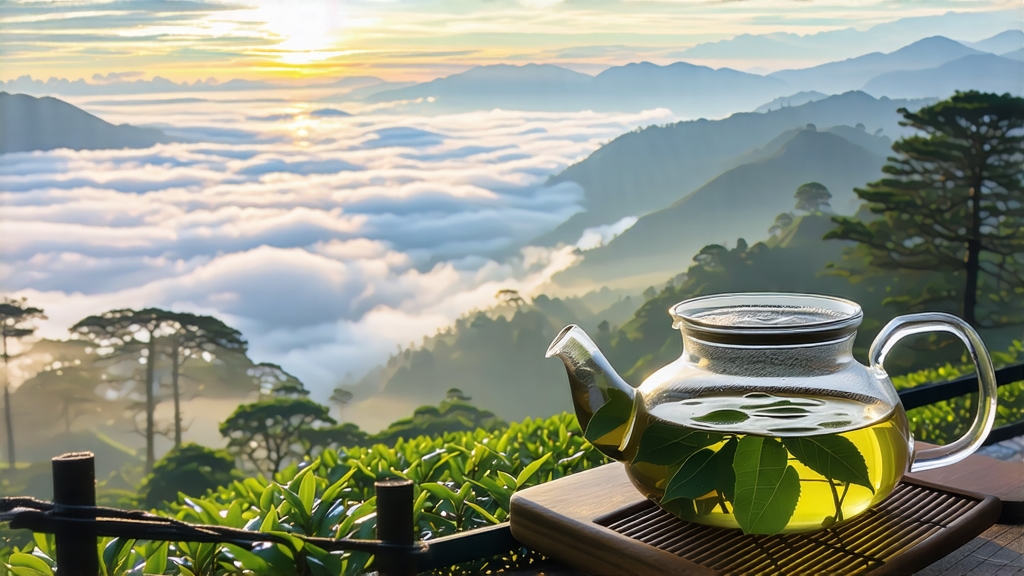
Alishan High-Mountain Oolong, known in Taiwan as Alishan Qing Xiang Oolong, is the island’s most fragrant ambassador to the world of fine tea. Grown between 1,000 and 1,400 meters on the forested spine of the Alishan range, this cultivar captures the chill of cloud forests, the sweetness of mountain springs, and the patience of farmers who still believe tea is a conversation between sky, soil, and hand. To understand it is to taste the altitude itself—an experience that begins long before the kettle boils.
History and Terroir
Tea bushes first climbed Alishan in the late 19th century when the Qing government encouraged Han settlers to replace opium poppies with tea. The experiment thrived; cool nights slowed leaf growth, concentrating amino acids and volatiles, while porous red volcanic soil drained quickly, forcing roots to dive deep for minerals. After 1980, when Taiwan’s tea industry pivoted from export commodity to boutique craft, Alishan farmers planted the modern Jin Xuan (TTES #12) and Qing Xin (TTES #13) cultivars at ever higher elevations, chasing the mist that now defines the appellation. Today, only leaves picked within the townships of Meishan, Zhuqi, Fanlu, and Alishan itself may legally bear the name “Alishan High-Mountain Oolong,” a protection akin to French AOC.
Cultivars and Seasonal Styles
Two bushes dominate the slopes. Jin Xuan, bred in 1981, yields a naturally milky aroma balanced by alpine florals; Qing Xin, the older heirloom, is more restrained, offering lilac and crushed green apple notes that linger like mountain echoes. Each cultivar is harvested five times a year, yet spring and winter flushes are most prized. Spring tea, kissed by winter dormancy, carries the highest concentration of linalool and geraniol, translating into heady hyacinth aromas. Winter tea, slow-grown under short daylight, is leaner, its sugars condensed into a crystalline sweetness that reminds tasters of snow on bamboo.
Plucking Standard
On the eve of Qingming or Dongzhi, depending on the season, teams of pickers climb before dawn. Only the “three-leaf and a bud” standard is accepted—mature leaves that have accumulated polyphenols but still snap with youth. Each picker wears a conical hat and a woven bamboo basket lined with banana leaf; the lining prevents bruising that would trigger premature oxidation. By 10 a.m., when mountain fog lifts and UV intensifies, plucking stops to preserve leaf moisture.
Withering: The First Breath
Back at the mountain factory, leaves are spread on bamboo trays stacked like sliding drawers in a humidified room kept at 22 °C. For eight hours they “walk,” as farmers say—slowly losing water while internal enzymes awaken. Every 45 minutes the trays are gently rattled to edge the oxidation forward; the sound is soft, like rain on a tin roof. When leaf edges turn jade-green and emit a faint pineapple scent, the batch is ready for tumbling.
Tumbling and Fixation: Choreographing Oxidation
The leaves are poured into a hexagonal bamboo drum that rotates like a carnival ride. Three minutes of tumbling bruises cell walls, releasing catechins and polyphenol oxidase. This step is repeated four times with 45-minute rest intervals; oxidation edges toward 25 %, the sweet spot for Alishan’s bright, floral profile. A final pass through a 200 °C conveyor oven halts oxidation, locking in the jade-green center and creamy rim that connoisseurs recognize at first glance.
Rolling and Ball-Formation: Crafting Memory
While still warm, leaves are wrapped in cotton cloth squares the size of handkerchiefs, then fed into hydraulic rollers that apply 30 kg of pressure for three minutes. The bundle is unwrapped, fluffed, and re-wrapped in a different orientation; this cycle repeats 25 times over two hours. Gradually, leaves curl into tight hemispheres that resemble tiny jade snails. The mechanical kneading ruptures cell walls further, coaxing juices to the surface where they will later crystallize into a glossy finish after drying.
Roasting: The Whisper of Charcoal
Unlike darker oolongs, Alishan High-Mountain receives only a “light bake.” Charcoal made from longan fruitwood is piled into